A Hut-to-Hut System in Vermont?
While hiking through the Green Mountains this fall, you might hear the bang of hammers, the snarl of saws and the whine of electric drills. It’s not what you’d expect for the middle of the woods, but around the state there’s been a frenzy to rebuild Vermont’s backcountry cabins.
One place that has been especially busy is near the top of Mt. Mansfield where crews have been installing new beams and sandblasting the charred stones of Vermont’s most famous cabin. It’s been nearly a year since the Stone Hut saw any overnight guests. News of the fire that destroyed the beloved cabin last December rippled through the region, drawing cries of outrage, shock and disbelief. When the ashes finally cooled, Vermont’s outdoor community wanted their hut back. Donors working with the state put forward the funds to make rebuilding it reality.
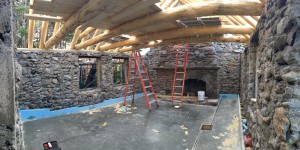
Built by the Civilian Conservation Corps in 1936, the hut served as a shelter for trail keepers in the summer. In the winter it was available for $225 a night via a lottery system managed by Vermont State Parks and the eight-bunk hut had become a huge favorite with skiers and riders.
It was, in some way the ideal: the old stone cabin sat just below treeline with no electricity or running water and heated only by a wood stove. Yet, it was steps from the Four Runner Quad, a ski patrol shack with heated bathrooms, the Octagon restaurant and the groomed trails of Stowe Mountain Resort.
The Stone Hut, in other words, provided that sense of being in the backcountry without ever really having to rough it. It was so wildly successful that you could apply for years through the lottery system and still not get a night there.
The story could easily end with the rebuilding, which Commissioner of Forest Parks and Recreation Mi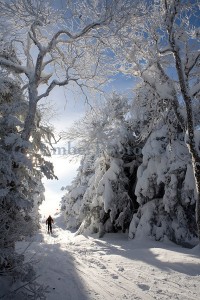 chael Snyder is cautiously optimistic will be completed during the 2017 ski season. “I can’t guarantee it,” Snyder said recently, “but we are working our hardest to get this place ready for skiers and riders this winter.”
chael Snyder is cautiously optimistic will be completed during the 2017 ski season. “I can’t guarantee it,” Snyder said recently, “but we are working our hardest to get this place ready for skiers and riders this winter.”
But many Vermonters aren’t content to jockey for a Stone Hut reservation. For many, the dream isn’t to spend just one day chasing the untracked experience at a resort—but to have several days living in the wild. They seek a true ski-in, backcountry adventure that ends at a cozy cabin with a wood stove, a rack to dry skins and stinky socks and a bunk where you can stretch out in a sleeping bag and dream.
After the Stone Hut fire, people around the state—including Commissioner Snyder and Sue Minter (the former Secretary of Transportation and now the Democratic candidate for governor)—began lending their voices to a widening chorus calling for a backcountry hut system in Vermont. Included in Minter’s platform VT-OUTDOORS, is to “promote hut and yurt systems for skiing, hiking and biking, similar to the popular 80-mile long Maine Huts & Trails system.”
“The community as a whole is increasingly excited about seeing a network of huts in Vermont,” says skier, photographer and Catamount Trail Association board member Brian Mohr. “They are so great at making it relatively easy to extend your time in the backcountry. We as a community have a lot to look forward to.”
Mansfield’s Stone Hut is just the start.
Picking Up the Hammer
On Dec. 23, Timothy and George Carpenter, the sons of Burton founders Jake and Donna Carpenter, were preparing the Stone Hut for some friends who were coming there. After propping open the stove door, the boys stoked the fire and left wet wood against it to dry. The friends never arrived. A Stowe Mountain Resort lift mechanic discovered the fire the following morning and Stowe Fire Department worked throughout the day and night to put out the blaze.
Since then, the Vermont Department of Forests, Parks and Recreation has launched “Vermont Parks Forever” to expand the reach and resources of Vermont’s parks. With the help of a $150,000 donation from Jake and Donna Carpenter, a campaign to rebuild the hut has raised a total of $162,000 from 41 donors as of this writing.
In other parts of the state, cabin and hut development is even farther along. In Braintree Mountain Forest, volunteers have been busy renovating a once dilapidated cabin at the end of an old logging road that now serves as the skin track.
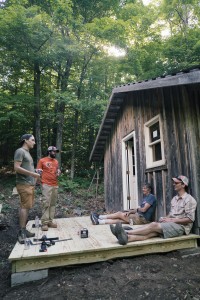
When volunteers began developing the first glades in the Braintree Mountain Forest in the fall of 2014, the Bell Gates Cabin—an overnight spot for loggers in the 1970s—was in disrepair; dead leaves and trash covered the floors and ratty screens hung in the windows.
Since then, the Bell Gates Cabin has gotten a facelift in the form of new windows and doors, insulation, a front deck and a new coat of paint.
“Its nothing glorious, but it has a much better feel to it,” Rochester Area Sports Trails Alliance volunteer Zac Freeman says. Freeman says the cabin will be available on a first-come-first-serve basis, but will be left for people to discover via RASTA’s site, rastavt.org.
“It is open to use and is on the trail map, but we’re going to try and not put too much effort into promoting it as a well-known location,” Freeman says. “This winter, people will know about it just from skiing in the area. We’re afraid of over-usage.”
Just off the trails of Bolton Valley, The Green Mountain Club, the Catamount Trail Association, Friends of Bolton Valley Nordic and Backcountry and others are working to restore two shelters, the Bolton Lodge and adjacent Bryant Camp. Contractors and GMC staff plan to stabilize the structures and improve drainage. New tables, benches, sleeping lofts, stoves, woodsheds and backcountry privy systems are all planned. With Act 250 paperwork submitted, the GMC and its volunteers hope to have work finished on Bryant Camp by the first snowfall of this season.
The project has finished its permitting for managing wastewater and work will begin on the Bryant Cabin this hiking season. Depending on how work on Bryant progresses, work on Bolton Lodge might wait until next year. “These cabins are part of a legacy of backcountry travel,” said Michael DeBonis, executive director of the Green Mountain Club. “Restoring them will allow future generations to enjoy them year-round.”
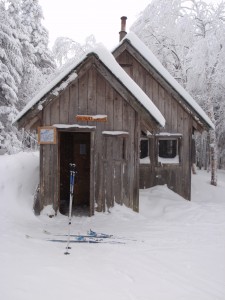
When finished, Bryant and the Bolton Lodge will be available to Catamount Trail skiers and Long Trail hikers, thanks to the camp’s location near both of these historic backcountry trails. Bolton Lodge and Bryant Camp will be managed by the GMC, which plans to implement a winter rental system, making it a possible overnight spot for Catamount Trail skiers making their way from the Bolton Valley Nordic trails to the backcountry of the Nebraska Valley.
The GMC is also looking for donations to fill a $16,000 fundraising gap as well as volunteers to come swing hammers and haul plywood.
“A dedicated base of volunteers is the only way you get these projects done,” DeBonis says.
A Hut-to-Hut Trail System?
Building and restoring cabins is just the start. Western mountain ranges have renowned networks of huts like the 10th Mountain Division’s network of 34 huts in the Colorado Rockies. Nearer to home, the Chic Choc mountains in Quebec’s Gaspe peninsula draw backcountry skiers to their multiple cabins. The same is true for the Adirondack Mountain Club huts in New York and huts maintained by the Dartmouth Outing Club, Randolph Mountain Club and Appalachian Mountain Club in New Hampshire’s White Mountains. Maine Huts and Trails, a non-profit in western Maine, manages a system of backcountry cabins on 80 miles of former logging trails open year-round for cross-country skiing and snowshoeing in the winter and mountain biking or hiking in the summer.
These huts feature a range of amenities, from full-service retreats with porters, bedding and hot tubs, to more Spartan affairs with a simple countertop, a few cots and a woodstove (you provide the rest).
Vermont is no stranger to backcountry travel and there are resources all over the state no matter your means of travel. The Long Trail is home to over 60 shelters along its 272 miles, including simple lean-tos and more developed cabins with four walls, woodstoves and bunks.
While staffed during the spring, summer and fall hiking seasons, the cabins along the high elevations remain open even when the snow flies. None are winterized, but for those with backcountry experience and a sleeping bag good into the single and negative digits, overnighting becomes possible.
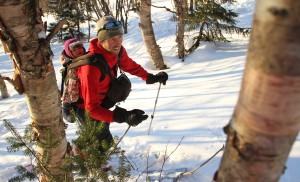
The Catamount Trail Association offers sample itineraries allowing skiers to travel between cabins or even from inn to inn on the Catamount, which stretches the length of Vermont. Brian Mohr and his wife Emily Johnson have even used the backcountry trail to ski from their home in the Mad River Valley to Stowe while staying at friends’ homes along the way, a trip he calls “skiing house-to-house.”
If those examples weren’t enough, at the end of many of Vermont’s abandoned logging roads stand derelict cabins or sheds that could be renovated to create backcountry destinations that could be used as basecamps for people exploring the surrounding area.
“If we’re going to have a system that’s successful, it’s going to have to be supported by land owners and private individuals who are willing to maintain cabins,” says Mohr. “It might be managed by a non-profit, the way the 10th Mountain Division manages and promotes the Colorado huts, but it would have to be a network that might include a variety of lodging ranging from cabins to yurts to inns.”
According to Mohr and others, a network of huts would allow people to spend more time in Vermont’s wildest places, disperse activities like backcountry skiing or bike packing throughout the state and serve as emergency shelters during extreme weather.
While the dream is big, there’s still much work to be done. Interested parties, including property owners and skiers, are starting to collaborate on ways to share and link existing shelters as part of the newly formed Vermont Huts Association.
“It’s a conversation that’s just getting started,” says Greg Maino, communications and events coordinator for the Catamount Trail Association. “Everyone wants to talk about the hut-to-hut experience in Vermont, but we’ve still got questions to answer.”
Questions like: Who owns and maintains the huts? Are they reserved months or weeks in advance or run on a first-come-first served basis? Who’s responsible for the firewood and where’s the bathroom?
It’s these questions—the simple but head-scratching ones—that a new organization is going to attempt to answer. This fall, a duo of diehard backcountry skiers created the Vermont Huts Association to chart and unify as many of Vermont’s huts as they can under a centralized system open year-round to skiers, bikers and hikers. Think of it like AirBnB for backcountry travelers.
“
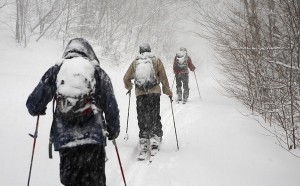
I find myself wondering how the heck this hasn’t happened yet,” says one of the group’s founders RJ Thompson, who also started the adventure race company Native Endurance last year. “Vermont’s an amazing place for year-round outdoor recreation. We have politicians talking about the importance of recreation in Vermont and so I think there’s a critical mass of indof individuals who are ready to make Vermont known as one of the greatest recreation states in the country.”
Cabin Fever
The group hopes to spearhead construction of additional yurts and cabins to complete a network from Massachusetts to Vermont. While it’s a scheme that could take upwards of ten to 20 years to come to fruition, Thompson and his co-director Devin Littlefield are willing to play the long game.
“Right now we’re mapping out what current hut options exist around the state and what the owners or hut operators would want out of an organization like the Association,” says Littlefield. “We’re talking about huts, cabins, yurts and even tree forts.”
A website and mission statement of the group is forthcoming and the pair intend to present their vision at the Vermont Backcountry Forum in Rochester, Vt. this November 3.
Back in the Braintree Mountain Forest, the Bell Gates Cabin is nearing completion after tearing down a wall and several old bunks to create a new entrance. A new stove will be installed later this fall, in time for the winter season and will be able to safely provide heat.
For RASTA’s Zac Freeman, it’s the start of something big. “The more you have to offer, the more fun it is,” he says.

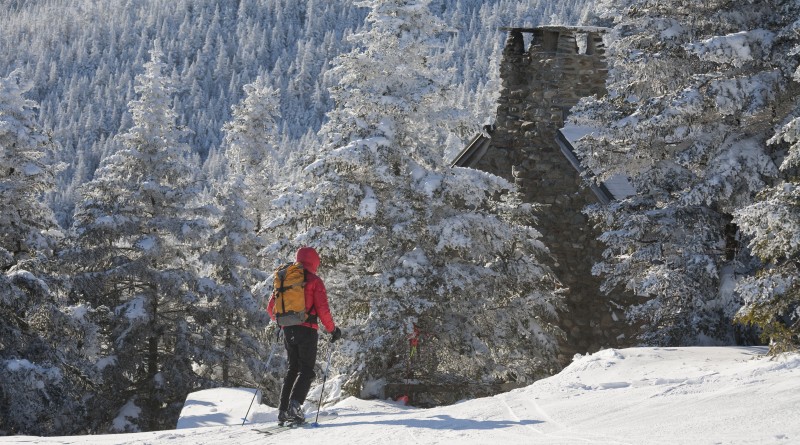
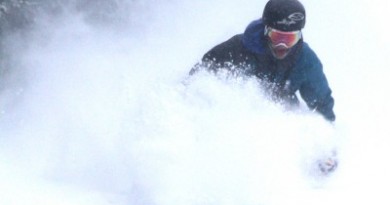
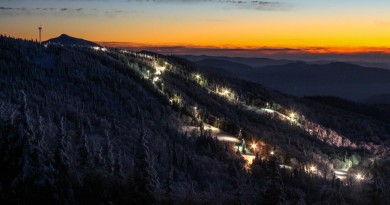
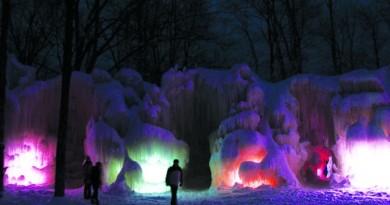
Pingback: Stone Hut Reservations Are Live - VT SKI + RIDE